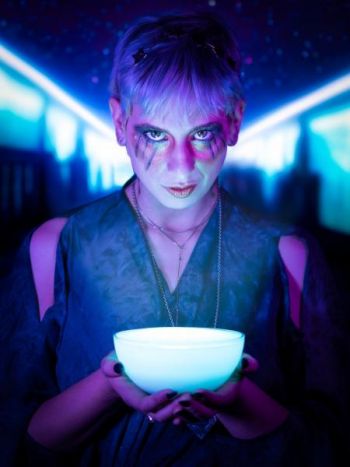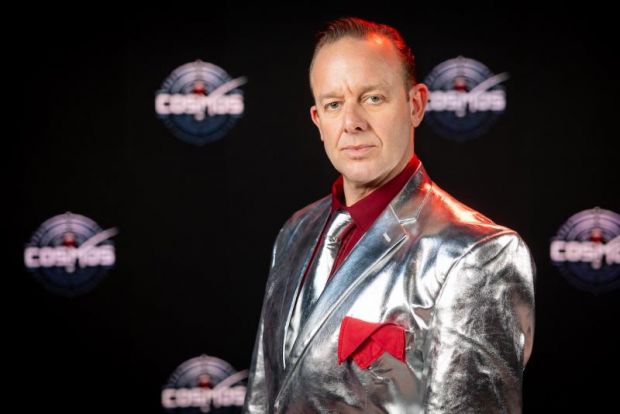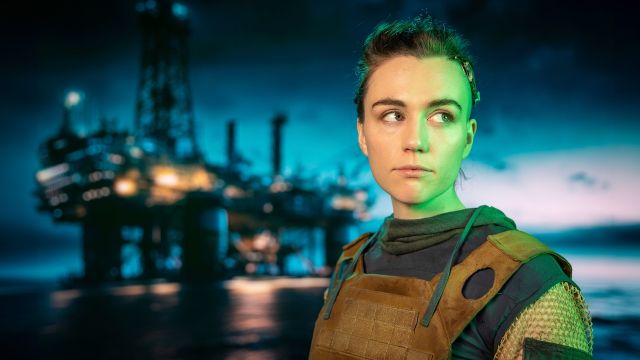Starweaver
Madness of Two is an innovative new theatre company, founded by theatre-makers Ellen Graham and Jamie Hornsby. In Starweaver, they are partnering with the State Theatre company and premiering a new piece of very high-quality science fiction performance with innovative staging and effects. Crafted with a cutting-edge blend of CGI and gaming technology, Starweaver is supported by, and hosted at Flinders University and was initially developed with the support of the Australian Writers’ Guild’s David Williamson Prize and was part of the Adelaide Festival Centre’s inSPACE Development Program. The venue is a unique performance space and with its concrete floor and black walls is perfect for this futuristic piece.
Science fiction’s ‘bread and butter’ is in challenging social issues, ethical and moral dilemmas and the thorny issues such as our known and possible legacy for the future of humanity. Starweaver allows us to speculate about alternative ways and places of life made possible by technological change, whilst seeing examples of technology manipulation and its use in real time. It is a catalyst for creativity and inquiry, and is a warning and a guide for humanity, a bridge to our potential future. No matter how fanciful the setting, it is a reflection of ourselves and what it means to protect and value what it is to be human. Having said that, Starweaver is ambitious, and if there is any criticism, it may be in the number of issues that are addressed.

The audience is introduced to Kit Donovan, seasoned actor, Mark Saturno in a beautifully scripted ‘teaser’ piece promoting ‘Starwalk’. Garbed in a shiny silver suit, evocative of, but nothing like a space suit, he struts and smirks at us from an enormous, dominating curved screen. He is its creator and we are assured that it will ‘allow life to be put into perspective.’ Given the fact that the year is 2149 and that Donvan, as head of COSMOS controls the world as they know it, we discover that biometric scanning ensures that he, and COSMOS know all about everyone and everything. Additionally, to clinch this, many people (often chosen dissidents or their families) have implanted brain chips, ensuring total control and obedience. The soothing voice of AI being, Caroline, used for interrogations sets the alarm bells ringing.
Fortunately, there are heroes, and the introduction of Cato, who is the daughter of a rebellious scientist and people’s hero, is an AI engineer turned revolutionary. Played by Madness of Two co-founder, Ellen Graham, Cato is a mesmerising, courageous and reckless hero. Adelaide College of the Arts graduate, Graham is an actor, playwright, physical performer and clown who seamlessly ‘becomes’ Cato. Her energy and use of space is inspirational and the add on of features such as (spoiler alert) face lighting is a stroke of genius. She is a performer to keep watching in future.
Playing the unhurried, lovable Cassius, Jamie Hornsby, the other company co-creator delivers a subtly nuanced performance. He too, is a hero who organises, mentors and protects, always empowering, always guiding. Hornsby also delivers a fine, believable performance and adds the wonderful element of a differently, non-stereotypical character, full of wit and quips as he strives to save humanity.
There is both a ‘live’ and pre-recorded cast, and the work of both seamlessly meshes, highlighting face to face and manipulated performance. This makes for a unique and always engaging audience experience. Maeve Hook as Terra portrays a warrior-leader with passion, strength and lightness where needed and is powerful as one of the three lead roles.

Capitalism is out of control, revolution bubbles on more than one planet, and no-one remembers seeing a real star in their lifetime. The Starweavers are gentle, optimistic, mediaeval looking creatures who guard the human link are important in this tale, and whilst largely well-acted by Rohan Becker, Mantra Bhatt and Shardae Santos, the link between them, and the title could be stronger in the writing.
The entire production team should be congratulated, including Jason Bevan’s collaboration on Visual effects and motion effects and the Flinders University Visual Effects and Entertainment Design students (VEED). As a self-confessed Sci-Fi fan, this play resonates strongly for me as new, refreshing, a twist on the genre, and a possible link to what we can expect from theatre in the not-too-distant future in ours, and galaxies not too far away.
Jude Hines
Subscribe to our E-Newsletter, buy our latest print edition or find a Performing Arts book at Book Nook.

